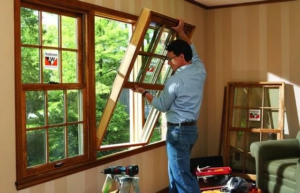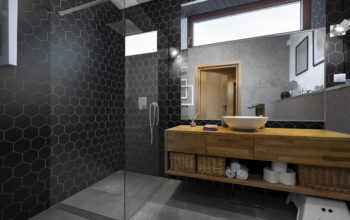Maryland Window Replacement offers homeowners a significant return on investment, especially when choosing energy-efficient windows. However, the price tag for window installation can vary significantly.
The type of window, frame material, customizations and install details all impact cost. Choosing the right contractor helps avoid structural damage, water infiltration and poor energy efficiency.

Replacement Windows
If you’re looking to upgrade the look and feel of your home, new windows can make a big difference. New windows add natural light and a fresh look to your living space and can also increase the resale value of your home.
If your windows have old, outdated locking mechanisms, replacing them will give you peace of mind and will make your home safer for families with children. In addition to improved security, many newer windows have features that reduce outdoor noise infiltration, which can be a major benefit if your home is located near a busy road or other noisy area.
Replacement windows are measured and custom-ordered to fit into an existing window opening, requiring less work than new construction windows. They can also be installed from the inside without removing trim or wall materials, which helps to save on costs.
New windows can be used in a variety of architectural styles, from traditional to contemporary, and they can be customized with a wide range of frame materials, colors, and finishing touches. This allows you to create a style that will blend well with the existing architecture and design of your home.
While new windows provide a number of benefits, older ones may still be allowing air, water, and ice to infiltrate your home, which can lead to rot, mildew, and high energy bills. Newer, more efficient windows offer superior insulation to help prevent this from happening and can significantly lower your energy bills.
If you want a more open, expansive feeling in your living space, new construction windows are the way to go. These windows attach their metal nail fin frames to the studs in your wall, holding them in place until the surrounding wall is finished. They’re a great option for adding a bigger window to an existing wall or for a whole-house remodel.
If you’re considering upgrading your home with new windows, be sure to plan ahead and keep in mind that the process can take up to a year. It’s important to choose a contractor who will work with you throughout the entire project, and to consider any issues that may arise during installation. For example, if your building is on a busy street, it’s important to schedule the window replacement project during the winter when traffic will be at its lowest. This will minimize any inconvenience to pedestrians and residents.
Replacement Sashes
The window sash is a key component in ensuring that your windows are energy-efficient and airtight. Despite its small size, it plays an essential role in the integrity of your entire window system by helping to prevent drafts and other problems that can occur when the window sash is not well-maintained. Window sashes can also help to create a moisture barrier, keeping out water and condensation that can lead to mold or mildew growth and wood rot.
Ideally, your window sash should move up and down with fluidity without sticking or causing much effort. If you notice that your sash is difficult to open or close, it’s probably time for a replacement. The window sash is also an important part of your window’s overall appearance and can significantly impact its insulation properties. If your window sash is damaged or worn, it can make your home look dated or unattractive.
It’s possible to replace just the sashes in an older window, but if your frame is rotting it may be better to invest in a full replacement. It’s also worth considering a casement or double-hung window replacement to take advantage of newer materials that offer greater energy efficiency and longevity compared to traditional wood sash windows.
A sash replacement kit includes a top or bottom window sash, compression jamb liners for both sides of the frame, a sill dam, and a head parting stop. To install the sash, you’ll need to remove any paint or caulk from the interior side of the frame. Then you can pry off the window stops (a thin strip of trim) that prevent the sash from coming out, using a utility knife to score any paint or caulk and then gently prying them off. The next step is to disconnect the balancing weight – a heavy iron or lead cylinder that’s attached to the sash with a rope. This can be difficult to do, but it’s usually easiest to cut the cord and sacrifice the balancing weight to allow it to fall into the pocket behind the trim.
Once the sash is removed, you can start to disassemble the frame and install the replacement components. This can be challenging, especially with older windows as the sashes are often held together by complicated mechanisms. Newer windows use a spring balance instead of a weighted mechanism, making them easier to disassemble and work with.
Replacement Frames
Window frames aren’t built to last forever, and they’ll eventually degrade over time. Factors like weather exposure, the frame material and upkeep can affect a frames lifespan. Fortunately, you can prolong the life of your window frame by performing regular maintenance and by choosing durable materials.
The type of window replacement product that’s right for you will depend on several factors, including your budget, timeline and energy efficiency goals. The installation method will also have an impact on the final outcome, and there are two primary methods: full frame replacement and insert windows.
Full frame replacements, also known as block-frame windows, involve replacing your entire existing window frame, including the head jamb, side jambs and sills. This is a more comprehensive installation that’s ideal for homes with older wood frames or those that have had previous problems with rotted frames, such as a faulty head jamb. With a full frame replacement, the old window and its sashes are removed down to the studs, allowing the installer to inspect and repair areas where rot or water damage have occurred.
While pricier than pocket replacements, full frame replacements offer greater design flexibility. This installation method allows for a stronger seal between the new window and frame, as well as the opportunity to change window styles, such as from double-hung to casement.
Alternatively, insert windows can be installed in an existing frame without removing the exterior cladding (i.e. siding, brick or stucco) or trim. This is a less expensive option that can be used in most situations, but it is limited to windows that are the same size and shape as the existing frame.
When choosing an insert window, it’s important to accurately measure your current window opening and frame size. This will ensure that the new replacement sash and operating hardware are a perfect fit, which is critical to achieving optimal energy performance. In addition, if your existing frame is warped or twisted, it will be difficult to properly install the insert. This could lead to air leaks and reduced thermal resistance, costing you money in the long run.
Replacement Glass
Often it’s only a single pane of glass that needs replacing in your window or door. Replacing just the window glass is significantly less expensive than replacing the entire window and can offer a very effective short-term solution in many cases. However, if your windows have more serious issues than just broken glass, then a replacement window will be a more complete long-term solution.
Window glass comes in different types with unique characteristics that make them better or worse for certain applications. The type of glass you choose will impact your home’s security, energy efficiency, protection and even the views.
Most modern windows are insulated with double or triple panes of glass, which is known as a “glass unit.” These units consist of two separate glass panes separated by a spacer and sometimes filled with gases such as argon or krypton to provide added insulation. The windows are then sealed together, and caulking and weather stripping are applied for a tight seal.
When you replace your windows with insulated glass units, you will save money in the long run because you won’t be paying to heat and cool your house through the window. You will also gain improved energy efficiency and reduced noise and air leakage.
If you decide to replace your window glass instead of a full window replacement, your installer will remove the frame, if needed, clean it and then insert the new insulated window glass. The installation process can take longer because the insulated glass needs to be cut to size and may require special tools to install properly.
Depending on the situation, you can try to do the work yourself to save some money. The key is to be very careful and understand the risks. If you don’t have any experience working with glass, this can quickly become a dangerous project. Additionally, you will likely need to use a lot of tape to keep the glass in place (which could damage the paint on the wood trim or sash), and the risk of getting shards of glass in your eyes or on your skin is very high.
